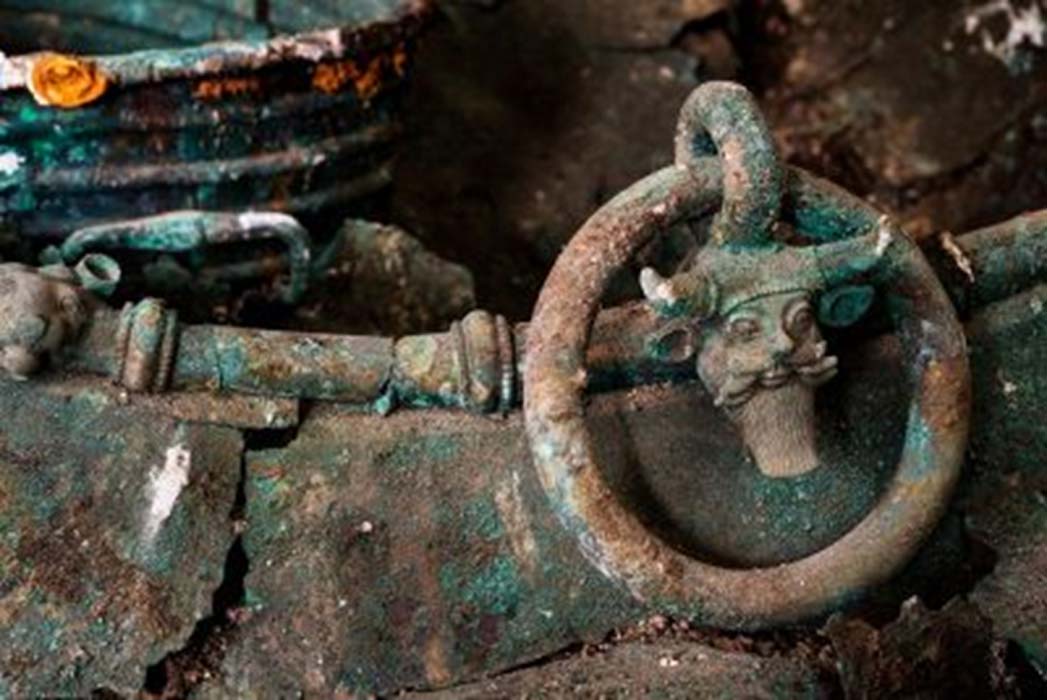Celtic Prince or Princess? Researchers Have Finally Ascertained Who Owned an Opulent 2500-Year-Old Tomb in France
First unearthed in 2015, research on the stunning artifacts found in a rich tomb in Lavau, France are finally coming to light. Scholars have managed to solve the mystery of the tomb’s owner and have provided some other exciting pieces of information on the rich grave goods.
The 2,500-year-old human remains were first discovered in 2015 when archaeologists were exploring a site in preparation for construction of a new commercial center. The tumulus (burial mound) was surrounded by a ditch and palisade. The tomb was said to be larger than the cathedral of nearby Troyes.
The body found in this huge burial mound was accompanied by a chariot, a vase depicting Dionysus, and a beautiful Mediterranean bronze cauldron adorned with castings of the Greek god Achelous and lions’ heads. These elaborate artifacts, along with a stunning gold necklace, bracelets, and finely worked amber beads adorning the skeleton, asserted the person's elite status.
- A rich Celtic Iron Age tomb discovered with stunning artifacts
- Fighting in the Buff: Did Celtic Warriors Really Go to War Naked?

Artifacts in the Celtic elite’s tomb in 2015. (Denis Gliksman, Inrap)
The French archaeological agency INRAP said the treasures of the tomb are “fitting for one of the highest elite of the end of the first Iron Age,” and told the media it is one of the most remarkable finds of the Celtic Hallstatt period of 800 to 450 BC.
Initially, the archaeologists were uncertain to whom the tomb pertained, first stating that a large knife found alongside the remains suggested it was made for a man, however, the rich golden jewelry opened the possibility that a Celtic princess may have been buried instead.
Now, IB Times reports the recent analysis of the shape of the pelvic bones has solved that mystery – it is today known as the ‘Lavau prince’s’ tomb.

The recent analysis of the shape of the pelvic bones has solved the mystery of the tomb’s owner – it was a Celtic ‘prince.’ (Denis Gliksman, Inrap)
Furthermore, the recent INRAP analysis of the bronze cauldron has shown researchers that its creator(s) had mastered smelting and engraving techniques. By using X-ray radiography, the researchers have found that the prince’s belt is unique and has Celtic motifs formed with silver threads. An examination of a knife sheath showed fine bronze threads. The researchers also saw that a gold torc and several gold bangles have marks where they rubbed against the prince’s skin.
- 2,500-year-old Celtic tomb with richly adorned body may belong to a Prince or Princess
- Examining the Rich Tomb of a Mysterious Celtic Princess
Finally, chemical analysis and 3-D photography show that a large jar that was used to pour wine combines Greek-style ceramic with golden Etruscan and silver Celtic designs. This is an important discovery for the researchers as it provides more evidence of a mix of cultural influences and supports the presence of economic and social interaction present amongst Celtic and Mediterranean people in the 5th century BC. As INRAP previously explained:
"The tomb contains mortuary deposits of sumptuousness worth that of the top Hallstatt elites. The period between the late 6th Century and the beginning of the 5th Century BC was characterized by the economic development of Greek and Etruscan city-states in the West, in particularly Marseilles. Mediterranean traders come into contact with the continental Celtic communities as they searched for slaves, metals and precious goods (including amber)."

Artifacts from the Celtic Lavau Prince’s tomb. (Denis Gliksman, Inrap)
The prince’s grave is considered one of the most important archaeological discoveries in France in recent decades and it has been compared to the 1953 unearthing of a grave for the 'Lady of Vix'.
INRAP reports that research concerning the prince’s tomb will continue until 2019, with hopes that more information will come to light.
Top Image: This bronze cauldron is one of the stunning artifacts which have been analyzed from the tomb of a Celtic elite found in Lavau, France. Source: Denis Gliksman, Inrap




















Comments
Really valuable article that attracted me to read and to translate. i translated it into my native language with providing a link to your article. also please continue writing. thank you